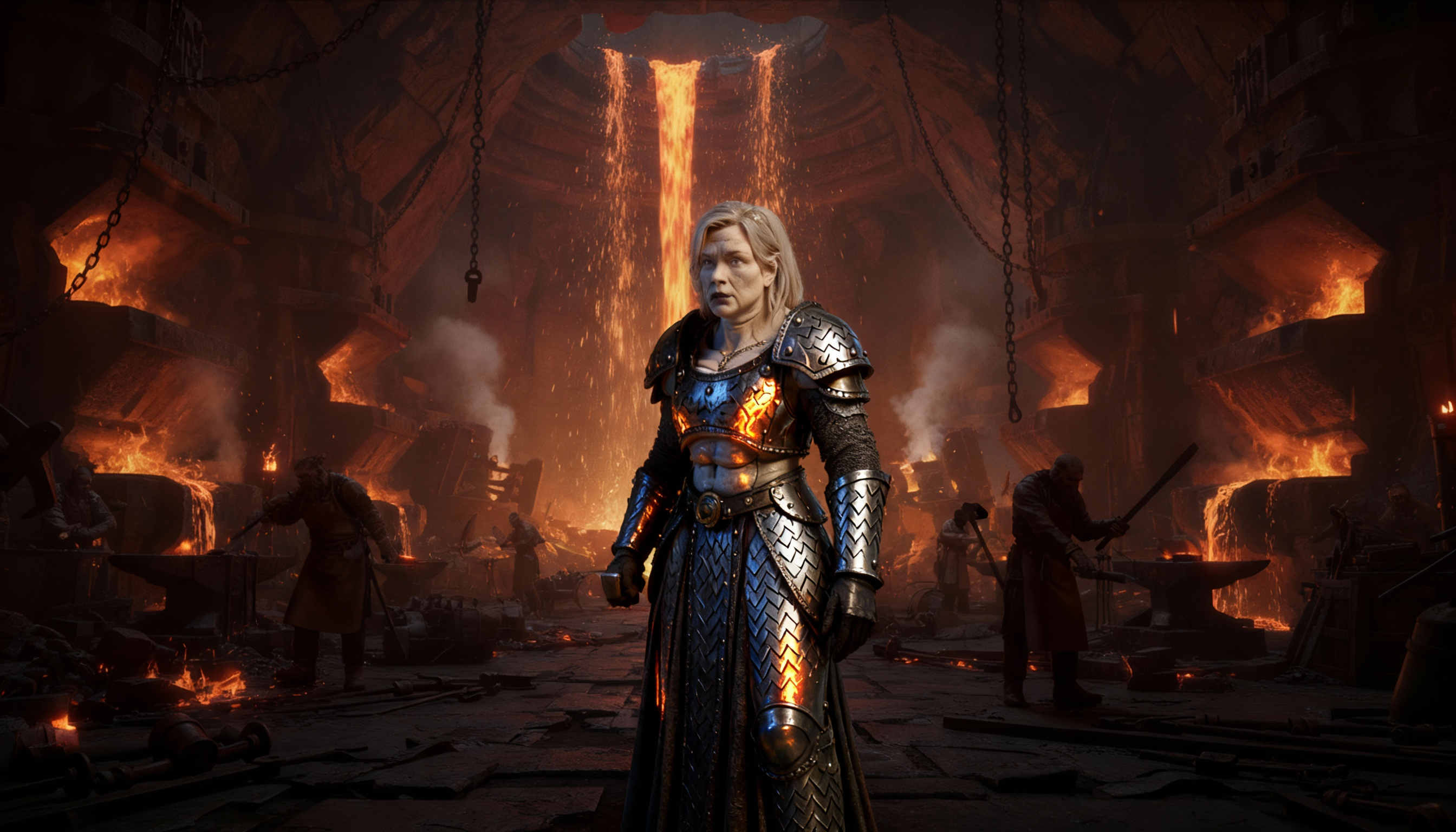The Iron Crown of Thrukal

Thrukal lies where the ridges of Camouros sink into volcanic valleys, a land of warm stone and restless rivers. The Duk who rule there call themselves the Forged-Born, children of Moab’s patience. Their halls are carved into the basalt faces that guard the Iron Road — a route linking the highlands of Camouros in the west to Kyvanoros in the east, and southward through the wooded reaches of Elossos. To the north, the arid lands of Qantherara and Tharvos glare down across the passes, but even their heat cannot dull Thrukal’s temper. The realm endures where others quarrel, its anvil-hymns ringing day and night.
The Duk measure nobility not by descent but by endurance. Each monarch must prove worthy through the Binding of Flame and Stone: three nights beside the Great Forge, without water or rest, while a crown of raw iron glows upon the anvil. When the metal cools, it is shaped by the ruler’s own hand and quenched in their blood. The crown thus remembers the strength of its bearer, and none have ever worn another’s.
The Winter of Three Kings
When King Orren the Pale fell from his forge platform into molten ore, the Iron Circlet shattered. Three claims rose from the embers: Kaer of the Western Forges, Varun the General of the Iron Road, and Isel daughter of the king. Kaer held Camouros’ trade routes; Varun commanded the army; Isel held only her father’s hammer and the loyalty of the guild-smiths of the Vales of Elossos. The mountains hummed with argument, and for sixty days the forges grew cold.
By decree of the Council of Ten Hammers, no army could draw steel within sight of the Great Forge. Instead, champions fought in ritual combat upon the Forge-Steps. Many fell, but no victor rose, and the people despaired. Then Isel Orren’s-blood, scarcely twenty winters, took up her father’s hammer and demanded the right of trial.
She faced Varun before the whole of Thrukal. He fought with a soldier’s fury; she fought with the rhythm of the forge. Three times she parried, three times she waited, and when his arm faltered, she struck once — not to wound, but to shatter his blade. “Strength without measure breaks itself,” she said. At that moment the mountain echoed as though struck from within. The molten veins beneath the city flared white, and the fragments of the Iron Circlet fused upon the anvil. Isel lifted the reforged crown bare-handed and placed it on her brow. Thus was Queen Isel Ironheart anointed by fire and stone alike.
The Queen of Anvils
Isel ruled for forty-three years. She rebuilt the forges that fed the Iron Road and opened trade with Kyvanoros’ highland smithies. Her decree that every anvil bear the sigil of three flames — one for each rival she had overcome — united the guilds into a single brotherhood of craft. Through Elossos her merchants sent plow-steel and temple bells; through Camouros came copper and grain. The air of Thrukal rang not with war but with work, and travelers said the realm smelled always of ash and new beginnings.
Yet peace drew envy. Raiders from Qantherara, driven by drought, crossed the northern ridges. They found not soldiers awaiting them, but smiths. Isel called every guild to arms and ordered the Great Forge fired as beacon. Its glare turned the sky red from Elossos to Tharvos. When the raiders descended, the passes had already been transformed — rivers of cooling slag sealed the narrow ways, and the defenders rained spears of tempered steel. The invaders broke like ore under hammer. Their warlord, known as Dren of the Wastes, was taken alive and brought before the queen.
“You sought the wealth of Thrukal,” she told him. “Learn the labor that makes it.” For ten years Dren worked as smith under the Guild of Stone-Singers, until his hands were as black as theirs. When released, he swore friendship to the Iron Crown and carried an anvil-stone back to his people. No raider from Qantherara crossed the Iron Road again in Isel’s lifetime.
Legacy of the Iron Crown
When Queen Isel Ironheart died, the forges fell silent for a full season. Her crown was placed upon the anvil where she had first forged it, and the fires beneath the mountain dimmed to embers. By tradition, no successor may wear the Iron Circlet until the Great Forge rings again of its own accord. Centuries later, the smiths of Thrukal still keep its bellows oiled, waiting for the day the metal sings once more.
In the halls of Camouros and Elossos, bards still honor the Queen of Anvils with a verse that echoes like steel upon stone:
“Strike once for strength, twice for grace, thrice for the mountain’s heart to wake. Hold your fire till the ore grows cold — for iron remembers what gold forgets.”

